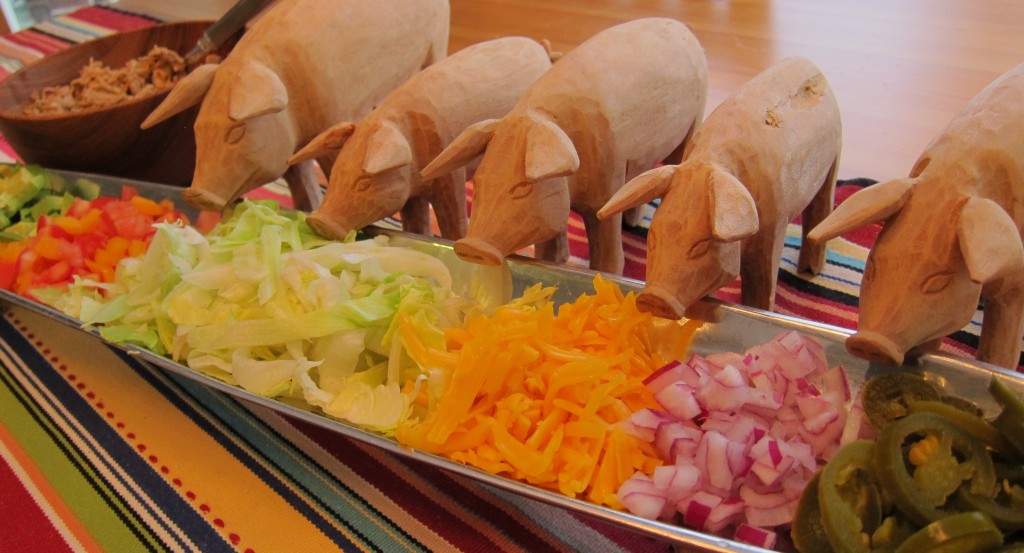Meet Josefina, who came home with me from a local thrift shop. As her sombrero advertises, she is from Mexico. Her blank stare has me convinced that Josefina is a Mexican Stepford wife:
 Do you remember The Stepford Wives, the 1972 novel by Ira Levin (who also authored Rosemary’s Baby)?
Do you remember The Stepford Wives, the 1972 novel by Ira Levin (who also authored Rosemary’s Baby)?
 The inside flap of the book jacket describes the novel as “one of those rare novels whose very titles may well become part of our vocabulary. For, after reading it, you will never forget Stepford and the horror it contains; and there is a certain kind of woman who, from now on, will be known as a Stepford Wife.” OK, if you say so.
The inside flap of the book jacket describes the novel as “one of those rare novels whose very titles may well become part of our vocabulary. For, after reading it, you will never forget Stepford and the horror it contains; and there is a certain kind of woman who, from now on, will be known as a Stepford Wife.” OK, if you say so.
Curious to see if the novel stood the test of time, I read the Stepford Wives, and let me tell you, this is one of the stupidest books I have ever read. The premise is that all of the men in Stepford belong to the Men’s Association, where they plot to kill their wives and replace them with robots. This is supposed to be believable because the President of the Men’s Association, known as “Diz,” worked in “audioanimatronics” at Disneyland, “helping to create the moving and talking presidential figures.” Other members of the Men’s Association are engineers, vinyl polymer researchers, specialists in microcircuitry, optical sensor designers — you get the picture. The robots look just like the wives, except that they have big boobs, tiny waists, dress like Donna Reed, and have immaculate houses. So for all their advanced degrees, are these guys idiots, or what? Haven’t they ever heard of mistresses and housekeepers?
What if instead of the men replacing the women with robots, the women replaced the men with robots? Can’t you just picture it? The men would come home from work — where they would go 7 days a week for at least 12 hours each day — and when they come home and their wives greet them at the door, the men say something like, “Oh, don’t you look pretty — those are my favorite sweat pants.” And when they ask what their wives made for dinner and the wives say “reservations,” the men toss their heads back and guffaw as if they have never heard that joke before and it is the funniest thing they ever heard. And then they whisk their ladies off to dinner and buy them surf AND turf, with no expectations of anything in return. Back at home, the men help the kids with their homework, while the women do . . . oh, who cares, as long as it doesn’t involve hot-gluing crap on a tri-board.
Anyway, I was curious to see what a Stepford wife cooked for her family in Ira Levin’s warped mind. To my surprise, there were no meals described in the book. The only references to food were coffee, a sandwich, shrimp on toothpicks, and “hot breakfasts.” I was surprised at the notion that the men of Stepford would prefer a clean house to a home-cooked meal, and wondered what kind of environment Mr. Levin grew up in. Did he never come home to the wonderful smells of a home-cooked dinner? I think the “design team” probably should have included Thomas Keller or Mario Batali or someone who knows what it takes to make a delicious meal.
Well, maybe they don’t eat in Stepford, but surely they drink. Inspired by the Mexican Stepford Wife, I made a batch (or two or three) of Classic Sangria. Technically, sangria is Spanish, not Mexican, but I challenge you to find a Mexican restaurant that doesn’t serve some version of sangria. This drink has been on my culinary bucket list for a long time, and this recipe is a great one. It’s a sneaky drink — it looks so innocent with the fruit floating prettily around in it, but be warned that the brandy and Grand Marnier in it pack quite a punch. I’ve served it three times in the last month or so (the last time I made a quadruple batch), and there is never a drop left.
- ½ cup Spanish brandy
- ½ cup triple sec or Grand Marnier
- ½ cup sugar
- 2 unpeeled oranges, thinly sliced into rounds
- 1 unpeeled lemon, thinly sliced into rounds
- 1 unpeeled lime, thinly sliced into rounds
- 1 (750-ml) bottle red wine
- ½ cup unsweetened lemon-flavored sparkling water (I use LaCroix)
- In a large pitcher or container with lid (I used a large Igloo jug), stir brandy, triple sec, and sugar together. Mix in fruit slices, cover, and allow the fruit to macerate in the refrigerator overnight or least 8 hours.
- Just before serving, add the wine and lemon sparkling water. Serve over ice.
I’ll take self-serve sangria over self-serve ice cream any day!






